Don't wanna be here? Send us removal request.
Text
The Ultimate Guide to Becoming a Full Stack Developer
Being a Full Stack Developer is all about versatility and adaptability. It requires mastering both front-end and back-end development, and understanding the full scope of how Full Stack Developer Course Online web applications are created, maintained, and scaled. So, what does it take to truly call yourself a full stack developer? Let’s dive into the essential skills you need to build to succeed in this career path.
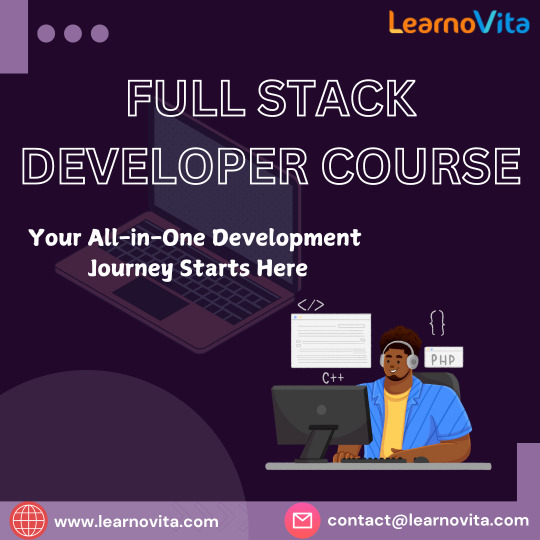
1. Front-End Mastery Front-end development is the face of a web application—the part users interact with. To become proficient in this area, you’ll need a strong grasp of:
HTML & CSS: These are the building blocks of the web. Learn to create clean, semantic HTML to structure content and use CSS to style your website. Don’t forget to master modern layout techniques like Flexbox and CSS Grid to make your designs responsive.
JavaScript: JavaScript is key for adding interactivity to your web pages. Understand its fundamentals, and dive into ES6+ features, asynchronous programming, and DOM manipulation to enhance user experiences.
JavaScript Frameworks: Get comfortable with frameworks like React, Vue.js, or Angular. They’re essential for building modern, scalable web applications.
Responsive Design: Learn to create websites that look great on any screen size. Responsive design principles and frameworks like Bootstrap or Tailwind CSS will help you ensure your designs are mobile-friendly.
2. Back-End Development Skills While the front-end is what users see, the back-end is what powers the app behind the scenes. As a full stack developer, your back-end skills should include:
Server-Side Languages: Learn at least one server-side language like Node.js, Python, Ruby, PHP, or Java. These are vital for handling requests, managing data, and ensuring your web app functions properly.
Frameworks: Frameworks like Express.js, Django, and Ruby on Rails can make back-end development faster and more efficient by providing structure and reusable components.
Databases (SQL & NoSQL): Know how to work with both SQL (such as PostgreSQL, MySQL) and NoSQL databases (like MongoDB) to store and manage data efficiently.
API Development: Build and consume APIs. Understand RESTful APIs and explore GraphQL for more flexible data querying.
3. Version Control As a developer, managing your codebase is crucial. You should be proficient in Git for tracking changes, collaborating with others, and maintaining version control. Platforms Best Online Training Programs like GitHub or GitLab are industry standards for hosting your repositories and collaborating on projects.

4. DevOps and Deployment Deploying a web application goes beyond writing code—it involves managing servers and ensuring your app runs smoothly in the real world.
Web Hosting & Cloud Services: Learn how to deploy applications on cloud services like AWS, Heroku, or DigitalOcean.
Containerization: Familiarize yourself with Docker to create consistent development and production environments. Knowledge of Kubernetes is a plus for managing large-scale applications.
CI/CD: Learn Continuous Integration and Continuous Deployment (CI/CD) practices using tools like Jenkins or CircleCI. This helps automate the process of testing, building, and deploying your code.
5. Security Practices In today’s digital landscape, security is critical. As a full stack developer, you need to:
Implement Security Features: Learn to secure your app by implementing authentication and authorization, preventing common vulnerabilities like XSS and SQL Injection, and using encryption for sensitive data.
Stay Updated: Keep up with the latest security best practices to protect user data and keep your application safe from threats.
6. Soft Skills Matter Beyond the technical skills, don’t forget about the importance of soft skills:
Problem-Solving: You’ll face many challenges in development—knowing how to think critically and solve problems is key.
Collaboration: Full stack developers often work in teams. Experience with Agile methodologies will help you collaborate effectively with designers, front-end developers, and other team members.
Communication: Whether you’re explaining technical details to non-technical stakeholders or working with other developers, clear communication is essential.
Conclusion To become a full stack developer, you need a broad set of skills that span both front-end and back-end development, along with version control, deployment strategies, and security practices. It’s a challenging but rewarding journey that can open doors to numerous career opportunities. If you’re passionate about building complete web applications and love the idea of being able to work on both sides of the stack, full stack development is a path worth exploring.
0 notes
Text
The Pros and Cons of Being a Full Stack Web Developer
Full stack web development is a career that combines creativity, technical skills, and problem-solving. It’s a role that lets you work on both the front-end and back-end of web applications, Full Stack Developer Course Online giving you the opportunity to see projects through from start to finish. But like any job, it comes with its pros and cons. Here’s a look at the advantages and challenges of being a full stack developer.

Pros:
1. Versatility and Broad Skillset
One of the biggest perks of being a full stack developer is the versatility you bring to the table. You work with both front-end and back-end technologies, meaning you can build, manage, and troubleshoot both the user interface and the behind-the-scenes operations of an app. This makes you a valuable asset to any development team and gives you a comprehensive understanding of how web applications function.
2. High Demand and Job Security
Full stack developers are highly sought after because of their ability to handle multiple parts of a project. Companies, especially startups and smaller teams, appreciate the flexibility Best Online Training Programs and cost-saving benefits of hiring someone who can do it all. This translates into more job opportunities and greater career stability.
3. Creative Freedom and End-to-End Involvement
Since you’re capable of handling both sides of development, full stack developers often have more creative control over the final product. You can design the front-end and also shape the functionality of the back-end, giving you the freedom to build complete applications that reflect your vision.
4. Increased Earning Potential
Because full stack developers bring a wide range of skills to the table, they often command higher salaries compared to developers who specialize in either front-end or back-end development alone. Employers are willing to pay for the convenience of having one person who can handle all aspects of a project.
5. Continuous Growth and Learning
Full stack development is never boring because there’s always something new to learn. As technology evolves, you’re constantly exposed to new tools, languages, and frameworks. This keeps the work interesting and helps you grow into a more versatile and valuable developer over time.
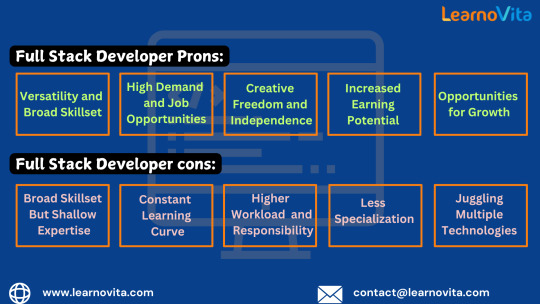
Cons:
1. Jack of All Trades, Master of None
While being a generalist has its advantages, it can also be a downside. Full stack developers are often knowledgeable across a wide range of areas but may not be experts in any single one. If you’re passionate about specializing deeply in a specific aspect of development, full stack work might not offer that focus.
2. Constant Learning Curve
Technology is always evolving, and full stack developers are expected to keep up with both front-end and back-end trends. The constant learning required can be overwhelming at times. You need to be willing to dedicate time to learning new technologies to stay current and competitive.
3. Heavier Workload and More Responsibility
Because full stack developers are responsible for both front-end and back-end work, the workload can sometimes be more demanding. Managing the complete development cycle can feel overwhelming, especially if you’re working in a small team or tight deadlines.
4. Limited Specialization Opportunities
If you’re someone who prefers to focus deeply on a specific area of development—like advanced UX design or data science—being a full stack developer may limit your chances of specializing. You’re expected to know a little about everything, but this can come at the cost of deeper expertise in a particular field.
5. Juggling Multiple Technologies
As a full stack developer, you’ll be working with a wide variety of tools and technologies. From HTML, CSS, and JavaScript on the front-end to databases and server-side programming languages on the back-end, you need to be comfortable with constantly switching gears. This can be mentally exhausting if not managed properly.
Conclusion:
Being a full stack developer comes with plenty of advantages—creative freedom, high demand in the job market, and continuous growth opportunities. But it also has its challenges, like juggling a broad set of skills, staying updated with fast-paced tech changes, and handling a heavier workload. If you enjoy wearing many hats and love the process of building complete applications from start to finish, full stack development could be the perfect career path for you. But if deep specialization is more your style, it’s important to weigh the pros and cons carefully before diving in.
0 notes
Text
The Key Qualities of a Full Stack Web Developer
Becoming a Full Stack Web Developer means mastering both the art of building beautiful front-end experiences Full Stack Developer Course Online and managing the complex back-end that powers applications. If you’re thinking of diving into this versatile role, here are some key skills you need to hone to succeed in today’s fast-paced tech environment.

1. Mastering Front-End and Back-End Development
A Full Stack Developer needs to be comfortable with both sides of web development:
Front-End: This involves working with HTML, CSS, and JavaScript to create interactive, responsive, and user-friendly interfaces. Knowing modern frameworks like React, Angular, or Vue.js will give you the tools to build smooth, dynamic web applications.
Back-End: Server-side programming with languages such as Node.js, Python, Ruby, Java, or PHP is crucial. Learning back-end frameworks like Express.js, Django, or Ruby on Rails helps in structuring apps and managing the server-side logic behind the scenes.
By mastering both front-end and back-end development, Full Stack Developers ensure that everything from user interface to data handling is seamless.
2. Strong Database Management Skills
Being able to manage data efficiently is another vital part of full stack development:
SQL Databases: Tools like MySQL and PostgreSQL store data in structured formats and are widely used for managing relational data.
NoSQL Databases: With databases like MongoDB, Full Stack Developers can handle more flexible, unstructured data for applications that require scalability and fast data retrieval.
This expertise ensures that developers can organize, store, and retrieve data smoothly, making sure that their applications perform well under pressure.
3. API Creation and Integration
Understanding how to build and integrate APIs (Application Programming Interfaces) is critical:
RESTful APIs: These are used to connect the front-end with the back-end, allowing users to interact with your web app.
Graph QL: This alternative to REST Best Online Training Programs allows for more efficient data querying, providing more control over the exact data needed for specific tasks.
Full Stack Developers who are comfortable with APIs make their apps more dynamic and capable of handling complex data interactions.
4. Knowledge of Version Control and Team Collaboration
When working on projects, especially in a team, version control is a must:
Git: Full Stack Developers should know how to track code changes using Git, ensuring smooth collaboration when multiple developers are involved.
Platforms like GitHub and GitLab: These tools help teams manage their projects, review code, and handle feature branches.
With version control, Full Stack Developers can work together more effectively and ensure high-quality, bug-free code.
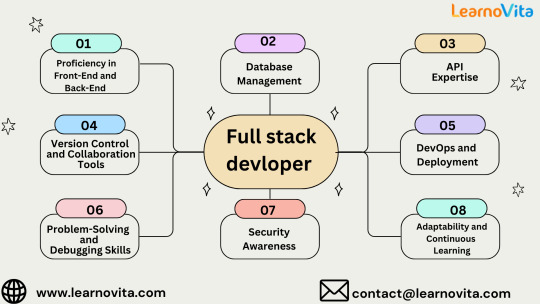
5. DevOps and Deployment Expertise
A Full Stack Developer’s job isn’t over once the code is written. Knowing how to deploy applications is just as important:
Cloud Hosting: AWS, Google Cloud, or Heroku are popular platforms for hosting web apps. Developers should understand how to deploy, manage, and scale their apps in these environments.
Containerization: Using tools like Docker to create consistent environments for your app across development, testing, and production makes the deployment process much smoother.
By having DevOps skills, Full Stack Developers can ensure that their apps are scalable, reliable, and ready to handle real-world traffic.
6. Problem-Solving and Debugging Abilities
Troubleshooting is a big part of any developer's life. Full Stack Developers need to be comfortable with:
Debugging Tools: Using browser developer tools or server-side loggers helps in quickly identifying bugs and performance issues.
Optimization: Beyond fixing bugs, developers should optimize their code to ensure applications load quickly and run efficiently.
With solid problem-solving skills, Full Stack Developers can resolve issues across the entire stack, ensuring a smooth user experience.
7. Security Best Practices
Security is a huge concern for web applications. A good Full Stack Developer needs to know how to protect their app from potential threats:
Preventing Vulnerabilities: Understanding threats like SQL injection, cross-site scripting (XSS), and cross-site request forgery (CSRF) is key. Developers should implement data validation, secure authentication, and encryption practices.
Encryption: Sensitive user data, like passwords or personal information, should always be encrypted both in transit and at rest.
By following security best practices, Full Stack Developers ensure that their apps are safe, secure, and trustworthy for users.
8. Adaptability and Continuous Learning
The tech landscape is constantly evolving, and Full Stack Developers must stay ahead by continuously learning:
New Tools and Frameworks: Keeping up with the latest programming languages, tools, and frameworks is essential to stay relevant in this fast-moving industry.
Methodologies: Many development teams use Agile or Scrum methodologies. Developers should be comfortable working in these environments to manage projects effectively.
Continuous learning is what keeps Full Stack Developers on top of their game, enabling them to build cutting-edge applications and keep their skills sharp.
Final Thoughts
Being a Full Stack Developer means being a jack-of-all-trades in web development, with the ability to work across both the front-end and back-end of an application. The role demands a diverse skill set, adaptability, and a strong commitment to learning. Master these skills, and you’ll be well on your way to building robust, secure, and scalable web applications in today’s tech-driven world.
0 notes
Text
The Path to Becoming a Full Stack Developer: A Comprehensive Guide
In today’s fast-paced tech world, Full Stack Developers have become indispensable. They are the multi-talented professionals capable of handling both the front-end and back-end of web development, making them invaluable when it comes to Full Stack Developer Course Online creating dynamic, high-performing web applications. If you’re aiming to become a Full Stack Developer, this guide will help you understand the skills and knowledge you need to succeed.

What is a Full Stack Developer?
A Full Stack Developer is a software engineer who has the ability to work on all aspects of a web application. From designing user interfaces to managing servers and databases, they oversee the entire development process. This makes them incredibly versatile and capable of delivering fully functional and user-friendly applications from scratch.
Here are the core skills that define a Full Stack Developer:
1. Front-End Development
Front-end development is all about what the user sees and interacts with. It includes:
HTML/CSS: These are essential for structuring and styling web pages.
JavaScript: This language allows developers to add interactive and dynamic elements to websites.
Frameworks/Libraries: Tools like React, Angular, or Vue.js help build responsive, fast, and scalable user interfaces.
Responsive Design: Ensuring that websites look good and work seamlessly across all devices, from desktops to smartphones, is a key component of front-end development.
2. Back-End Development
Back-end development focuses on the server-side logic and databases that support the front-end. Important back-end skills include:
Programming Languages: Proficiency in languages like Node.js, Python, Ruby, or Java is crucial for managing servers and handling data.
Frameworks: Full Stack Developers often use back-end frameworks like Express.js (for Node.js), Django (for Python), or Ruby on Rails to streamline their work.
Databases: Understanding how to manage both SQL (like MySQL, PostgreSQL) and NoSQL databases (such as MongoDB) is a must for storing and retrieving data efficiently.
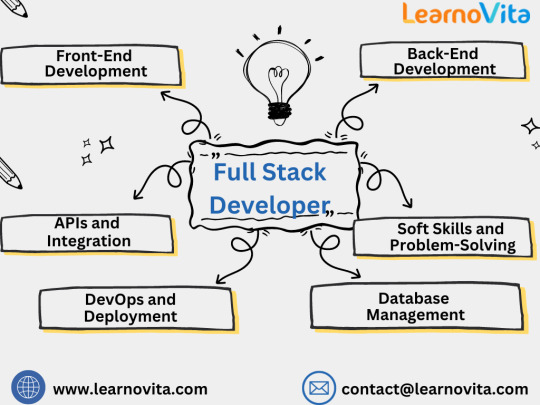
3. APIs and Integrations
APIs (Application Programming Interfaces) play a vital role in connecting the front-end and back-end of an application. Full Stack Developers are skilled in building and integrating RESTful APIs or Graph QL to ensure smooth communication Best Online Training Programs between different parts of an app. APIs also allow for the integration of third-party services like payment systems or authentication tools.
4. DevOps and Deployment
Full Stack Developers are often involved in deploying and maintaining applications. They use tools like Git for version control and platforms like AWS, Heroku, or Google Cloud for hosting. Knowledge of CI/CD pipelines (Continuous Integration/Continuous Deployment) helps them automate testing and deployment, ensuring applications are delivered quickly and reliably.
5. Soft Skills and Problem-Solving
In addition to their technical expertise, Full Stack Developers need strong problem-solving abilities to tackle complex challenges. Whether it’s debugging code or optimizing performance, creative solutions are key. They also need excellent collaboration and communication skills, as they often work closely with designers, project managers, and other developers.
Why Full Stack Developers Are So In-Demand
Full Stack Developers are highly valued because of their versatility. They can handle both front-end and back-end tasks, making them incredibly useful for smaller teams, especially startups, where developers need to wear multiple hats. In larger organizations, their ability to bridge the gap between different teams ensures that front-end and back-end components work together smoothly.
Conclusion
Becoming a Full Stack Developer can open up a world of opportunities in the tech industry. By mastering front-end and back-end technologies, database management, and deployment processes, you’ll be able to build complete web applications that are user-friendly and scalable. It’s a challenging path, but if you’re passionate about web development and eager to learn, there’s no better time to start your journey into the world of Full Stack Development.
0 notes
Text
Your Path to Becoming a Full Stack Web Developer
If you're looking to dive into web development and want to become a Full Stack Developer, you're in the right place! Full Stack Developer Course Online Here's a step-by-step guide to help you navigate the journey from beginner to full stack expert.

1. Start with the Basics
Everything begins with the basics:
HTML/CSS: Learn the essentials. HTML builds the structure of a webpage, and CSS makes it look good.
JavaScript: This is the magic that makes web pages interactive. You'll need a solid grasp of JavaScript to move forward.
2. Front-End Development
The front end is all about what users see and interact with:
Advanced HTML & CSS: Learn modern layout techniques like Flexbox and CSS Grid to design beautiful, responsive web pages.
JavaScript Mastery: Dive deep into modern JavaScript (ES6+) to create dynamic, interactive web applications.
Frameworks & Libraries: Familiarize yourself with tools like React, Vue.js, or Angular. These help you build complex apps faster and easier.
Version Control: Git is a must. Learn how to use GitHub or GitLab for collaboration and version control.
3. Back-End Development
The back end is the engine behind your web app:
Server-Side Languages: Pick a language like Node.js, Python, Java, or Ruby. Full stack developers often start with Node.js because it uses JavaScript, making it easier to switch between front and back-end tasks.
Back-End Frameworks: Get to know frameworks like Express (Node.js), Django (Python), or Ruby on Rails to streamline your development process.
Databases: Learn to work with both SQL (e.g., MySQL, PostgreSQL) and NoSQL (e.g., MongoDB) databases to store and manage data.
REST APIs & Graph QL: Learn how to create and consume RESTful APIs and explore Graph QL to make your apps more interactive and flexible.

4. DevOps & Deployment
Knowing how to deploy your app is crucial:
Web Hosting: Learn how to deploy your apps on platforms like AWS, Heroku, or Digital Ocean.
Containerization: Get familiar with Docker for consistent development environments, and explore Kubernetes for scaling apps.
CI/CD: Implement Continuous Integration/Continuous Deployment (CI/CD) to automate testing and streamline deployment.
5. Security Best Practices
Security is non-negotiable:
Security Basics: Understand Best Online Training Programs vulnerabilities like SQL injection and XSS, and apply best practices to keep your apps safe.
Authentication: Learn how to implement secure user authentication with tools like OAuth or JWT (JSON Web Tokens).
6. Sharpen Your Soft Skills
It's not all about code. Your ability to work with others matters too:
Problem-Solving: You’ll need sharp problem-solving skills to tackle challenges that arise during development.
Collaboration: Teamwork is key. Learning how to collaborate, especially in Agile environments, is essential.
Communication: Be ready to explain technical concepts to non-tech folks in a way they can understand.
7. Build, Build, Build
The best way to learn is by doing:
Personal Projects: Start small, then gradually take on more complex full-stack projects.
Contribute to Open Source: Get involved in open-source projects to gain experience and build your portfolio.
Freelance or Internship: Try out real-world projects by freelancing or interning to apply your skills in a professional setting.
8. Stay Up to Date
Web development evolves fast, so keep learning:
Follow Trends: Keep up with the latest tools, frameworks, and best practices. Join developer communities, follow blogs, and attend webinars to stay informed.
Explore New Tech: New tools like JAMstack and concepts like microservices architecture are emerging—don’t be afraid to dive into them and broaden your knowledge.
Conclusion
Becoming a Full Stack Developer is a journey that requires dedication, continuous learning, and hands-on practice. Master front-end and back-end skills, learn to deploy and secure your applications, and never stop expanding your knowledge. Web development is a fast-moving field, and staying adaptable is the key to long-term success. You got this
0 notes
Text
Becoming a Full Stack Developer: Skills and Tools You Can’t Ignore
Becoming a full stack developer involves gaining expertise in both frontend and backend technologies, Full Stack Developer Course Online enabling you to work across the entire scope of web development. To excel in this role, developers must master various programming languages, frameworks, databases, and tools. Let’s dive into what you need to know to succeed as a full stack developer.

Frontend Technologies Frontend development is where user interaction happens, so full stack developers must have a solid understanding of HTML and CSS. These are the building blocks for structuring and styling web pages. JavaScript, along with frameworks like React, Angular, or Vue.js, is essential for creating interactive, dynamic user interfaces. Responsive design is also crucial, ensuring that your applications look and perform well on any device, from desktops to mobile phones.
Backend Technologies Equally important is understanding backend technologies, which involve server-side programming and managing databases. Full stack developers should be proficient in languages like Node.js, Python, Ruby, Java, or PHP, and have experience with backend frameworks like Express.js, Django, or Ruby on Rails. Additionally, knowing how to build and consume RESTful APIs is key to connecting the frontend and backend components of an application.
Databases and Data Management Managing data effectively is a vital part of any application, and full stack developers should be Best Online Training Programs skilled in using databases. Whether it’s SQL databases like MySQL or PostgreSQL for structured data or NoSQL databases like MongoDB for unstructured data, a good understanding of database management is crucial. It’s also important to understand data modeling and how to design efficient database schemas.
Version Control Systems Version control is essential for managing code efficiently, especially when working on larger projects or collaborating with others. Full stack developers must be comfortable using Git for version control, along with platforms like GitHub or GitLab for code repositories. Knowing how to handle branching, merging, and managing changes in the codebase is key to effective collaboration and project management.

Development Tools and Workflow Full stack developers use various tools to streamline development processes and boost productivity. Proficiency in using text editors or integrated development environments (IDEs) like Visual Studio Code, Atom, or Sublime Text is essential. Familiarity with build tools such as Webpack, Gulp, or Grunt is also important for automating tasks and optimizing workflows. Additionally, package managers like npm or Yarn are used for managing dependencies.
Testing and Debugging Testing is critical for ensuring code quality and application performance. Full stack developers should know how to write unit tests to verify individual components and integration tests to ensure that different parts of the application work together smoothly. Debugging skills are equally important for identifying and fixing issues in both the frontend and backend code.
DevOps and Deployment In today's world, full stack developers often need to understand DevOps practices and how to deploy applications. Familiarity with cloud services such as AWS, Azure, or Google Cloud is increasingly important for hosting and scaling web applications. Understanding containerization tools like Docker and working with continuous integration/continuous deployment (CI/CD) pipelines can automate the deployment process and improve efficiency.
Soft Skills In addition to technical expertise, full stack developers need strong soft skills to succeed. Good communication skills are vital for collaborating with team members and explaining technical concepts to non-technical stakeholders. Problem-solving abilities are critical for identifying and addressing issues in development. Adaptability is also important, as the tech landscape constantly changes, and developers need to stay updated with the latest tools and technologies.
Conclusion A successful full stack developer needs a wide range of skills that cover both frontend and backend development. Mastering these areas will allow you to build and manage web applications efficiently. Continuous learning and staying up-to-date with the latest trends and technologies will help you thrive in this ever-evolving field.
0 notes
Text
Skills Every Full Stack Developer Should Have
A Full Stack Developer Course Online needs a wide range of skills that cover both front-end and back-end development, plus deployment and maintenance. Here’s a breakdown of the essential areas of expertise
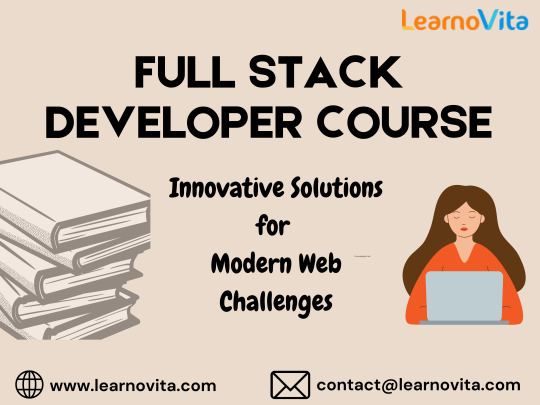
1. Front-End Development
HTML/CSS: Knowing semantic HTML and CSS is key for building well-structured and visually appealing websites. Mastery of layout techniques like Flexbox and CSS Grid is a must.
JavaScript: Being proficient in JavaScript, especially with ES6+ features, helps create interactive and dynamic user experiences.
Frameworks/Libraries: Familiarity with front-end frameworks like React, Angular, or Vue.js is essential for building scalable applications efficiently.
Responsive Design: Understanding mobile-first design and using frameworks like Bootstrap or Tailwind CSS ensures your sites look great on all devices.
2. Back-End Development
Server-Side Languages: You should be skilled in at least one back-end language, like Node.js, Python, Ruby, Java, or PHP.
Frameworks: Knowledge of back-end frameworks such as Express (Node.js), Django (Python), or Ruby on Rails helps structure your projects and speeds up development.
Database Management: Understanding both SQL (PostgreSQL, MySQL) and NoSQL (MongoDB) databases Best Online Training Programs is vital for effective data handling.
RESTful APIs: The ability to create and consume RESTful APIs, plus a basic grasp of Graph QL, enhances app interactivity.
3. DevOps and Deployment
Web Hosting: Familiarity with hosting solutions like AWS, Heroku, or DigitalOcean and effective deployment strategies is crucial.
Containerization: Knowledge of Docker and tools like Kubernetes helps create consistent development and production environments.
CI/CD: Understanding Continuous Integration and Continuous Deployment practices streamlines your workflow and ensures quality releases.
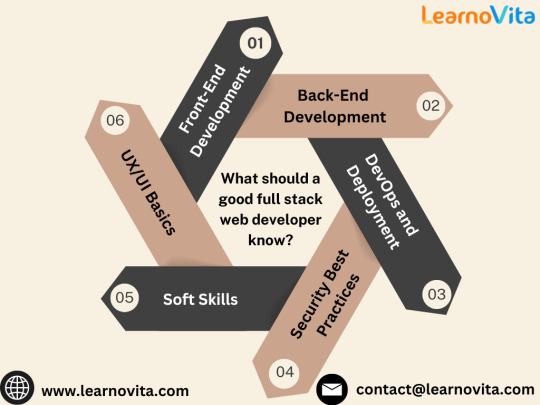
4. Security Best Practices
Basic Security Principles: Being aware of common vulnerabilities (like SQL injection and XSS) and knowing best practices for securing applications is essential.
5. Development Tools
Text Editors/IDEs: Proficiency in tools like Visual Studio Code or your favorite IDE can really boost your productivity.
Debugging Tools: Familiarity with browser developer tools and effective debugging techniques is vital for resolving issues.
6. Soft Skills
Problem-Solving: Strong analytical skills are necessary for tackling technical challenges creatively.
Collaboration: Experience working in teams, often using Agile methodologies, is key for timely project delivery.
Communication: Being able to explain technical concepts to non-technical folks is essential for effective teamwork.
Conclusion
By developing these skills, full stack web developers can create and maintain robust web applications, making significant contributions to their teams. Focusing on these core competencies will help you thrive in the fast-paced world of web development, keeping you relevant in an ever-changing landscape.
1 note
·
View note